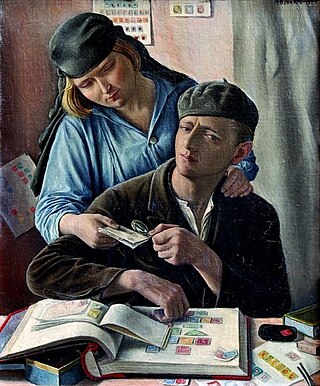
Stamp collecting is the collecting of postage stamps and related objects. It is an area of philately, which is the study of stamps. It has been one of the world's most popular hobbies since the late nineteenth century with the rapid growth of the postal service, as a stream of new stamps was produced by countries that sought to advertise their distinctiveness through their stamps.

A stamp catalog is a catalog of postage stamp types with descriptions and prices.
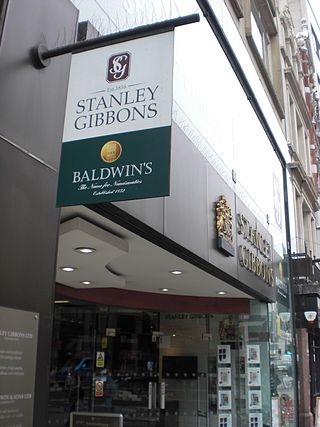
The Stanley Gibbons Group plc is a company quoted on the London Stock Exchange specialising in the retailing of collectable postage stamps and similar products. The group is incorporated in London. The company is a major stamp dealer and philatelic publisher. The company's philatelic subsidiary, Stanley Gibbons Limited, had a royal warrant of appointment from Queen Elizabeth II.

James Alexander Mackay was a prolific Scottish writer and philatelist whose output of philatelic works was rivalled only by Fred Melville. He was described by John Holman, editor of the British Philatelic Bulletin, as a "philatelic writer without equal" but his reputation was damaged by a conviction for theft from the British Museum early in his career, which cost him his job there, and multiple accusations of plagiarism.

The first Stanley Gibbons stamp catalogue was a penny price list issued in November 1865 and reissued at monthly intervals for the next 14 years. The company produces numerous catalogues covering different countries, regions and specialisms; many of them are reissued annually. The catalogues list all known adhesive postage stamp issues and include prices for used and unused stamps.

Telegraph stamps are stamps intended solely for the prepayment of telegraph fees. The customer completed a telegraph form before handing it with payment to the clerk who applied a telegraph stamp and cancelled it to show that payment had been made. If the stamp was an imprinted stamp, it formed part of the message form.

The postage stamps of Ireland are issued by the postal operator of the independent Irish state. Ireland was part of the United Kingdom of Great Britain and Ireland when the world's first postage stamps were issued in 1840. These stamps, and all subsequent British issues, were used throughout Ireland until the new Irish Government assumed power in 1922. Beginning on 17 February 1922, existing British stamps were overprinted with Irish text to provide some definitives until separate Irish issues became available within the new Irish Free State. Following the overprints, a regular series of definitive stamps was produced by the new Department of Posts and Telegraphs, using domestic designs. These definitives were issued on 6 December 1922, the day that the Irish Free State officially came into existence; the first was a 2d stamp, depicting a map of Ireland. Since then new images, and additional values as needed, have produced nine definitive series of different designs.
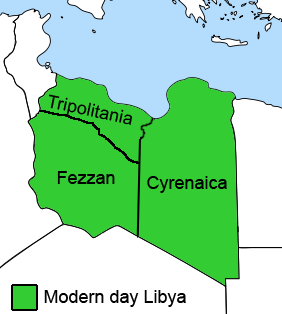
This is a survey of the postage stamps and postal history of Tripolitania, now part of Libya.

A stamp dealer is a company or an individual who deals in stamps and philatelic products. It also includes individuals who sell postage stamps for day to day use or revenue stamps for use on court documents. Stamp dealers who sell to stamp collectors and philatelists are of many kinds and their businesses range from small home operations to large international companies.

In philately, a cut-out is an imprinted stamp cut from an item of postal stationery such as a postal card, letter sheet, aerogramme or wrapper that may have been used as a normal stamp.
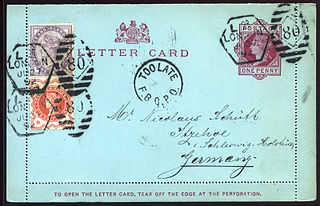
In philately, a lettercard or letter card is a postal stationery item consisting of a folded card with a prepaid imprinted stamp. That it is folded over gives the writer twice as much room for the message compared with a postal card. The message is written on the inside and the card is then folded and sealed around the edges. The recipient tears off and discards the perforated selvages to open the card.

Bahrain first used the postage stamps of British India before eventually issuing its own stamps in 1960.
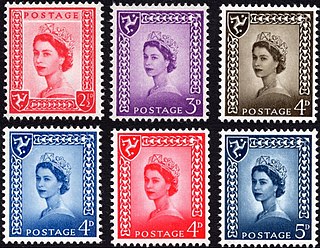
This is a survey of the postage stamps and postal history of the Isle of Man.
This is a survey of the postage stamps and postal history of Brunei.

This is a survey of the postage stamps and postal history of Liechtenstein.
This is a survey of the postage stamps and postal history of Grenada.

The Universal Private Telegraph Company, Limited was formed in 1861 to exploit Professor Charles Wheatstone’s 1858 Universal Telegraph. The company was meant to "carry out a system by which banks, merchants, public bodies and other parties may have the means of establishing a telegraph for their own private purposes from their houses to their offices, manufactories or other places".

Bonelli's Electric Telegraph Co. Ltd. was formed in August 1860 by Henry Cook, an American, of 69 Lincoln's Inn Fields, London, and Eastbourne, with an initial capital of £25,000. The company was formed to exploit the telegraph system of Gaetano Bonelli of Italy, but the firm had limited success, and it failed in 1864.

The London District Telegraph Company was formed in 1859. It was renamed the London and Provincial Telegraph Company in 1867.

















